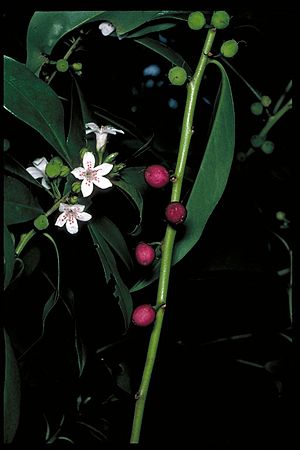Popwood facts for kids
Quick facts for kids Popwood |
|
|---|---|
 |
|
| Conservation status | |
| Scientific classification | |
| Genus: |
Myoporum
|
| Species: |
obscurum
|
Popwood, also called sandalwood or bastard ironwood, is a special plant. Its scientific name is Myoporum obscurum. This plant belongs to the figwort family. Popwood is very rare. It only grows naturally on Norfolk Island. You can find it in just a few places there.
Contents
What Popwood Looks Like
Popwood can be a spreading bush or a small tree. It sometimes grows as tall as 6 meters (about 20 feet). Its shape can be like a dome.
Leaves
The leaves of the popwood plant grow one after another along the stem. They are thin and shaped like an oval or a spear. Each leaf is about 7 to 13.5 centimeters (2.7 to 5.3 inches) long. They are also about 2.5 to 4 centimeters (1 to 1.6 inches) wide. The top side of the leaf is shiny. The bottom side is dull. You can easily see a clear vein in the middle of the leaf. The edges of the leaves are wavy. Sometimes, they have a few small teeth near the tip.
Flowers and Fruit
Popwood flowers grow in groups of 3 to 6. They appear where the leaves meet the stem. Each group of flowers grows on a flat stalk. These stalks are about 6.5 to 11 millimeters (0.25 to 0.43 inches) long. Each flower has 5 sepals, which are like small leaves that protect the bud. It also has 5 petals. These petals join together at their base to form a tube.
The flower tube is about 4 to 6 millimeters (0.16 to 0.24 inches) long. The petal tips are about the same length as the tube. The tube is white. It has purple spots on the petal tips and inside the tube. The inside of the tube is also hairy. There are 4 stamens, which are the parts that make pollen. These stamens stick out a little past the petal tube. After the flowers, the plant grows fruit. The fruit is oval-shaped and reddish. It is a type of fruit called a drupe, which means it has a hard pit inside.
Naming Popwood
The scientific name Myoporum obscurum was first officially described in 1833. This was done by a scientist named Stephan Endlicher. He published his description in a book called Prodromus Florae Norfolkicae. The first plant used to describe the species was found on Norfolk Island. It was found by Ferdinand Bauer. The second part of the name, obscurum, comes from a Latin word. It means "indistinct" or "dark."
Where Popwood Lives
Today, only a few popwood plants are left. They are found in just a few spots on Norfolk Island. In the 1830s, popwood was common on nearby Phillip Island. However, most of the plants there were lost in the 1800s. This happened because animals like rabbits were brought to the island. These animals caused a lot of soil erosion.
In 2003, only 5 popwood plants were known on Norfolk Island. All of them were inside the national park. Since then, people have created a plan to help the species. Many new popwood plants have been planted. Popwood does not grow well in the shade. It is usually found at the edges of forests.
Popwood's Environment
Scientists do not know much about how popwood interacts with its environment. However, they do know that it is in danger. It faces competition from weed species. Weeds are plants that grow where they are not wanted. They can take up space and resources that popwood needs.
Protecting Popwood
Myoporum obscurum is listed as "critically endangered." This means it is at a very high risk of dying out in the wild. This listing is under the Australian Government's Environment Protection and Biodiversity Act. Efforts are being made to protect this rare plant.


